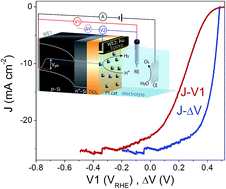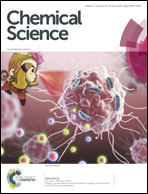Operando deconvolution of photovoltaic and electrocatalytic performance in ALD TiO2 protected water splitting photocathodes†
Abstract
In this work, we demonstrate that buried junction photocathodes featuring an ALD TiO2 protective overlayer can be readily characterized using a variation of the dual working electrode (DWE) technique, where the second working electrode (WE2) is spatially isolated from the hydrogen-evolving active area. The measurement of the surface potential during operation enables the operando deconvolution of the photovoltaic and electrocatalytic performance of these photocathodes, by reconstructing J–ΔV curves (reminiscent of photovoltaic J–V curves) from the 3-electrode water splitting data. Our method provides a clearer understanding of the photocathode degradation mechanism during stability tests, including loss of the catalyst from the surface, which is only possible in our isolated WE2 configuration. A pn+Si/TiO2 photocathode was first investigated as a well behaved model system, and then the technique was applied to an emerging material system based on Cu2O/Ga2O3, where we uncovered an intrinsic instability of the Cu2O/Ga2O3 junction (loss of photovoltage) during long term stability measurements.

- This article is part of the themed collections: Most popular 2018-2019 energy articles and In celebration of Kazunari Domen’s 65th birthday, 2018


 Please wait while we load your content...
Please wait while we load your content...